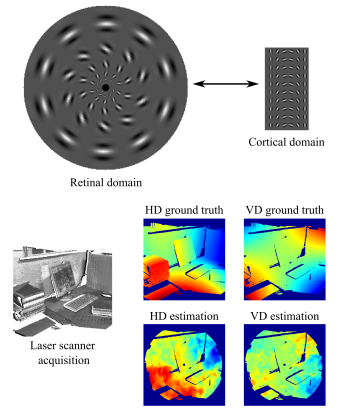Breaking news
[Back to archive]
The latest results achieved by the project consortium.
Visual feature extraction in foveated systems

Fig 1: Top: Space-variant representation of a bank of Gabor filters.
Bottom: Comparison between the estimated disparity maps and the ground truth for a stereo pair obtained from a real scenario acquired by a laser scanner.
The log-polar imaging is a well established paradigm for simplifying a wide number of computational problems in active vision, since simultaneously provides a wide field-of-view, high spatial resolution on the fovea, and a significant data reduction. These features are well suitable for visual systems that continuously interact with the environment, by purposefully moving the eyes to bring the interesting objects into the foveas.
We have addressed the problem of the multi-orientation and multiscale filtering in the log-polar domain. To this aim, a systematic analysis of the relationships between the parameters of the discrete log-polar mapping and of a bank of Gabor filters has been carried out (see Fig 1 top). We performed a systematic analysis to see how the energy ratio between the response of a mapped filter (i.e., a filter mapped into the cortical domain) and the response of a matched filter (i.e., a filter directly defined in the cortical domain), is affected by the relationships between the parameters of the log-polar mapping and of the Gabor filter.
The major outcome of this analysis is the definition of a set of general design rules, that allow us to use algorithms, which were originally designed in the Cartesian domain, directly in the log-polar space, without requiring specific modifications. Moreover, we have deduced a novel rule to efficiently implement a multi-scale analysis, by exploiting the space-variance of the log-polar mapping. The validity of such analysis has been proved by applying the distributed phase-based approach for the computation of vector binocular disparity based on a bank of Gabor filters (click here for more details) on log-polar stereo pairs. The distributed algorithm for the computation of the 2D vector disparity is suitable to be directly applied on cortical images, since 2D vector disparity is computed without an explicit search of the correspondences, between the left and the right images, along the epipolar lines. In this way, it is not necessary to take into account that the straight lines in the Cartesian domain become curves in the log-polar space.
The obtained results show that it is possible to recover reliable values of the horizontal and vertical disparities by directly applying the algorithm in the cortical domain, thus achieving a consistent reduction in the execution time (see Fig. 1 bottom). The possibility of efficiently exploiting a space-variant representation is of great importance in the development of active systems capable of interacting with the environment, since a precise processing of the visual signal is possible in the foveal area, where the feature errors are small enough to allow a fine exploration of the object of interest. At the same time, the coarse computation of the feature in the peripheral area provides enough information to detect new saliencies and to bring the focus of attention there.
M. Chessa, S.P. Sabatini, F. Solari
Department of Biophysical and Electronic Engineering (DIBE)
University of Genoa
|